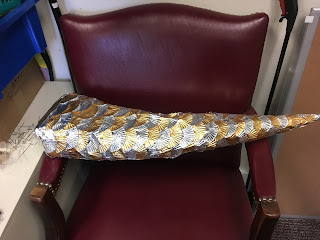Yesterday, we had an extremely successful (read: record numbers... 37 in attendance!) Homeschool Program about CLAY.
Unfortunately, I was too busy to take pictures. I did collect photographs taken by other library staff members though, so we have a few!
Our primary product for the clay program was Minnesota Clay Company Rainbow Air-dry Clay (purchased here ). We didn't have the time or funding for kiln work here at the library, but this clay was perfect for what we needed. It comes in a variety of colors (so the kids all got to pick their favorite), and dries within a few days. The clay itself is a good quality, heavy material. It doesn't feel like play-dough or polymer clay... it feels very close to a typical sculpting clay.
The kids rotated between four stations for the program.
STATION ONE: COILS
The kids used clay to make a coil pot. They rolled ropes ("snakes") of clay between their hands, and then coiled it around in a circle to form a container. the bottom of this bowl was made with a flat circle of clay, or with a tightly coiled spiral from one of their ropes.
STATION TWO: THROWING
We used some banding wheels that we bought from Amazon, so the kids could get a chance to try working clay on a wheel. Without access to a pedal wheel, these actually worked very well. It isn't too hard to spin the wheel with one hand, and hold a tool to the side of your clay with the other. It was also very helpful for doing a 'pinch-pot' style bowl, keeping fingers steady to pinch as the project rotated. The banding wheels we got are very sturdy and solid. They spin very cleanly, and cost about $35. For cheaper alternatives, a plastic cake decorating wheel would probably work for smaller/lighter projects.
It wasn't quite 'throwing' in the traditional sense, but it did work nicely when combined with pinch pot directions. The kids made a ball of clay, setting it in the center of the wheel. They pressed one finger into the middle of the ball, and then pinched the walls as they spun the wheel with one hand. After they got the basic shape down, they could make designs along the sides of the bowl. If you dip a fingertip into a bowl of water, it's easy to smooth out the sides. We were also able to create curves in the pottery by holding a finger (or tool) in place while spinning the wheel. After the pot was finished, we slid a bit of fishing line underneath to separate it from the wheel.
STATION THREE: GLAZING
We knew the projects wouldn't be dry by the end of the program, but I still wanted everyone to get a chance to "finish" a piece of pottery. Since everything was air-dry, I created a bunch of clay pieces in the week or two before our program. They were all some form of small bowls, but each one had different curves and shapes to it (32 in all, made from the Minnesota Clay Company's air-dry white). At this station, each kid got to pick a piece of pottery that was already hardened so that they could glaze it.
For a cheap air-dry 'glaze,' we used Glossy Mod Podge. We mixed in liquid food coloring so that there were color options. When this is applied in a thin, smooth layer, it creates a somewhat translucent, glossy, hardened shell (seriously... you would have sworn some of those projects were glazed and fired).
STATION FOUR: FREE SCULPT
At this station, kids were able to try their hand at sculpting anything they wanted. There were dogs, houses, caterpillars... a turtle, a snowman, and even a dojo. We provided blocks of rainbow clay and tons of tools. We used Rubber Tipped tools, wooden ribs, and this awesome set of 38 wooden clay tools we found online. A few of these were spread out to other stations (especially the throwing station), but most of them were available for the kids to use as creatively as they wanted. We had a few books set out with pictures of famous artwork in pottery and sculpture that they could use for reference.
NOTES:
A few things that helped us out...
- We used wax paper to cover a couple of the tables, and pre-cut chunks of clay with fishing line to set out for kids to pick up as they needed. This was much easier than digging out handfuls as they were needed.
- We used squares of card stock for the kids to place their projects on, with sharpies so they could include their names. This helped us keep track of whose projects were whose, and allowed the kids to carry the (still wet) projects without accidentally smashing them.
- Instead of letting each kid get a brush to paint on their mod podge, we had brushes for specific colors. When they switched colors, they switched brushes too. If the brush was not in use, it was on a piece of paper labeled with its color. This way the colors didn't mix.
- PARENTS. As I stated earlier, we had more kids than we anticipated (most months we get about 12). The parents who came to the event were awesome about helping to cover the stations, and running to get things from the desk for me. This was super helpful, and I can't thank them enough.






















































